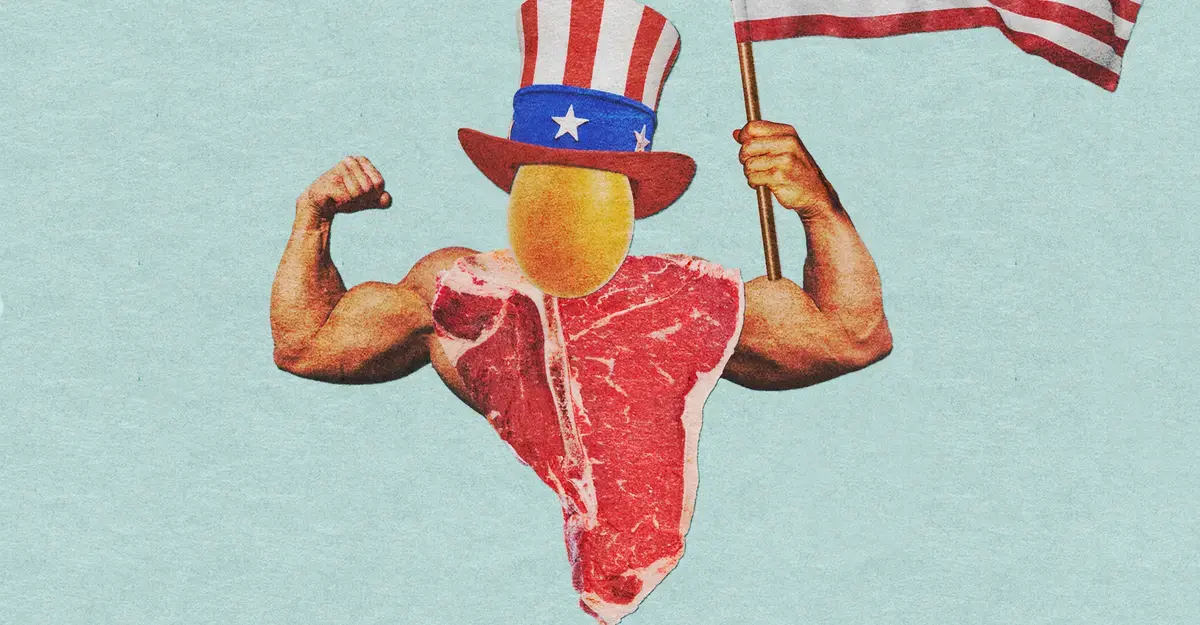Unless we are the Rock, no. Our body mass is different, our gut biome is different, our energy level is different…
The point is- don’t ever eat like someone else. Not these YouTube clowns, not some random fit celebrity. Eat like YOU need to eat. For you.
Removed by mod
Are you seriously stalking my comments? Grow the fuck up.
Removed by mod
So, the rock is the guy that carries muscle mass 7 - 10 times what normally fits his frame because of steroids supporting it instead of his gonads, right? Obvious answer then is -no. Not unless you are blasting all kinds of PED.
I am no expert by any means, but my experience (in decades of sports and experimentation) is really close to a study I 've seen in the past, that proposed 0,8 to 1,6-2 grams per kg of bodyweight. I go for the upper limit when I increase activity (especially strength related, instead of endurance), I go for the lower limit when I decrease activity. Been healthy and strong during all this time.
As for food I try to find the least amount possible my body needs to process (why overload my vital organs? is there a good reason?) in order to support my lifestyle (active, and heavy on sports). Going for the most amount possible without a good reason, I consider greedy and harmful for both the environment and the rest of the people. Resources are not limitless.
As for the expensive part, protein exists in cheaper foods too, not everyone relies heavily (or at all) on animal products. Simple (cheap, especially if you prepare them yourself) examples: legumes & beans, seitan, tofu (and all kinds of tofu related products), tempeh. Especially legumes & beans are incredibly rich in most of the other important nutrients too. One might consider vital wheat gluten a protein powder (almost 80grams of protein in 100grams total), even though its lacking a bit in the amino-acids that legumes/beans are full of, comparing the price it has with an actual protein supplement makes it pretty clear what overpriced means.
Pea Protein is a complete protein with all of the essential amino acids. It has slightly less of a few of them, but there are scientific studies showing equivalent or almost equivalent (depending on age) value as whey protein. An added benefit is that it doesn’t leave you feeling bloated or give you gas and your skin will look healthier than when consuming a lot of whey.
Well, I try not to use supplements when I can go for real food, so I wouldn’t know which protein powder is more effective… I enjoy peas even though I don’t eat them often. The foods I mentioned were examples of cheap protein sources. Vital wheat gluten (which is actually an ingredient for meals) is more than 4 times cheaper than pea protein powder in my area and roughly the same amount of amino-acids. All the rest of the nutrients (and the amino-acids it has on lower concentrations) gluten doesn’t have and may exist in a pea protein powder supplement, exist in the rest of the options I mentioned :-)
For years, the American approach to protein has been a never-ending quest for more. On average, each person in the United States puts away roughly 300 pounds of meat a year; we are responsible for more than a third of the multibillion-dollar protein-supplement market. Our recommended dietary allowance, or RDA, for protein is 0.8 grams per kilogram of body weight per day—a quota that a 160-pound person could meet with a couple of eggs in the morning and an eight-ounce steak at night. American adults consistently eat well above that amount, with men close to doubling it—and recent polls show that millions of us want to increase our intake.
The American appetite for protein is, simply put, huge. And still, Jose Antonio thinks we’re getting nowhere near enough.
The RDA of 0.8 grams per kilogram is “nothing, literally nothing,” Antonio, a health-and-human-performance researcher at Nova Southeastern University, in Florida, told me. “Most of my friends get that at breakfast.” In an ideal world, Antonio said, totally sedentary adults should consume at least twice that; people who seriously exercise should start with a minimum of 2.2 grams per kilogram, and ramp their levels up from there. (Antonio is also a co-founder of the International Society of Sports Nutrition, which has received sponsorships from companies that sell protein supplements.)
In Antonio’s pro-protein world, people would be fitter, more energetic, and suffer less chronic disease; they’d build muscle more efficiently, and recover faster from workouts. There is no definitive cap, in his view, on how much protein people should strive for. The limit, he said, is “How much can a human consume in a single day?”
Among nutritionists, Antonio’s viewpoint is pretty fringe. There is, other experts told me, such a thing as too much protein—or at least a point of rapidly diminishing returns. But researchers don’t agree on how much protein is necessary, or how much is excessive; they’ve reached no consensus on the extent of its benefits, or whether eating extra servings can send our health into decline. Which leaves Americans with no protein ceiling—and plenty of room for our protein hunger to grow, and grow, and grow.
Read: You’re probably drinking enough water
Not having enough protein is clearly very bad. Protein is essential to the architecture of our cells; we rely on it for immunity and hormone synthesis, and cobble it together to build muscles, skin, and bone. Among the three macronutrients—the other two being carbohydrates and fat—protein is the only one that “we need to get every day,” Joanne Slavin, a nutrition researcher at the University of Minnesota, told me. Nearly half of the 20 amino-acid building blocks that make up protein can’t be produced in-house. Go without them for too long, and the body will start to break its own tissues down to scavenge the molecules it needs.
That state of deficiency is exactly what the protein RDA was designed to avoid. Researchers decided the threshold decades ago, based on their best estimations of the amount of protein people needed to balance out their loss of nitrogen—a substance that’s in amino acids but that the body can’t itself make. The average person in the study, they found, needed 0.66 grams of protein per kilogram of body weight to avoid going into the red. So they set the guidelines at 0.8, a level that would keep the overwhelming majority of the population out of the deficiency zone. That number has stuck in the many years since, and Slavin, who has sat on the Dietary Guidelines Advisory Committee, sees no reason for it to change. People who are expending extra energy on growth, or whose muscles are taxed by exercise or aging, might need more. But for the typical American adult, Slavin said, “I think 0.8 is the right number.”
Others vehemently disagree. The current standard is “not enough to support everyday living,” Abbie Smith-Ryan, a sports-nutrition expert at the University of North Carolina at Chapel Hill, told me. Adults, she and others told me, should be getting more like 1.2 or 1.6 grams per kilogram at baseline. Their beef with the RDA is twofold. For one, the original nitrogen analyses oversimplified how the body metabolizes and retains protein, Stuart Phillips, a protein researcher at McMaster University, in Canada, told me. And second, even if the 0.8 number does meet our barest needs, “there’s a much more optimal amount we should be consuming” that would further improve our health, Katie Hirsch, an exercise physiologist at the University of South Carolina, told me. (I reached out to the USDA, which helps develop the U.S.’s official Dietary Guidelines, about whether the RDA needed to change; a spokesperson referred me to the National Academy of Sciences, which said that the RDA was last reviewed in 2002, and was expected to be reviewed again soon.)
If Hirsch and others are right, even people who are slightly exceeding the government guideline might not be maximizing their resilience against infections, cardiovascular disease, metabolic issues, muscle loss, and more. People who are working out and still eating the measly 0.8 grams per kilogram per day, Antonio told me, are also starving themselves of the chance to build lean muscle—and of performance gains.
But the “more” mentality has a limit. Experts just can’t agree on what it is. It does depend on who’s asking, and their goals. For most people, the benefits “diminish greatly” past 1.6 grams per kilogram, Phillips told me. Smith-Ryan said that levels around 2.2 were valid for athletes trying to lose weight. Antonio is more liberal still. Intakes of 3.3 or so are fair game for body builders or elite cyclists, he told me. In one of his studies, he had athletes pack in 4.4 grams of protein per kilogram of body weight for weeks—a daily diet that, for a 160-pound person, would require three-plus pounds of steak, 16 cups of tofu, or 89 egg whites.
Read: The Jordan Peterson all-meat diet
That is … a lot of protein. And most of the other experts I spoke with said that they didn’t see the point, especially for Americans, who already eat more protein than people in most other countries. “There’s very little evidence that more is better,” Marion Nestle, a nutrition researcher at New York University, told me.
The worry isn’t necessarily that tons of protein would cause acute bodily harm, at least not to people who are otherwise in good health. Over the years, researchers have raised concerns that too much protein could damage the kidneys or liver, leach calcium from the bones, or even trigger cancer or early death—but the evidence on all fronts is, at best, mixed. In Antonio’s high-protein studies with athletes, he told me, their organs have remained in tip-top shape. The known drawbacks are more annoying than dangerous: High-protein diets can raise the risk of bloating, gas, and dehydration; burning through tons of protein can also make people feel very, very hot. Roughly a quarter of the participants in Antonio’s ultra-high-protein study dropped out: Many of them felt too full, he told me, and no longer enjoyed food. One volunteer was so plagued by night sweats by the close of the trial, he said, that she could no longer fall asleep.
Whether many years of an ultrahigh-protein lifestyle could be harmful is less clear. Native communities in the Arctic have healthfully subsisted on such diets for generations, but they’ve had a long time to adapt; those in Western society might not fare the same.
Over the years, it’s gotten easy to interpret protein’s apparent lack of immediate downsides as permission to reach for more. But for now, many experts would rather err on the side of moderation. “Would I feed that much to one of my relatives? I would not,” Susan Roberts, a nutrition researcher at Tufts University, told me. Even if protein itself turns out not to be hard on the body, the foods it comes in still might be, including processed meats or sugary “high-protein” powders, shakes, cookies, chips, and bars. People pounding protein also risk squeezing other nutrients out of their diet, Roberts told me—whole grains, nuts, fruits, and vegetables, all of them packed with fiber, a vital ingredient that nutritionists actually do agree we lack.
Read: Selling the fantasy of high-protein everything
Plus, Slavin argued, there’s a point at which excess protein becomes a straight-up waste. When people eat more than about 20 to 40 grams of protein in a single sitting, their protein-processing machinery can get overwhelmed; the body eliminates the nitrogen as waste, then treats the rest as it would a carbohydrate or fat. “You can get fat on proteins just like you can get fat on carbohydrates,” Slavin told me. Which makes overdoing protein, in her eyes, “expensive and stupid.”
The excess can have consequences beyond what our own bodies endure. Meat production drives greenhouse-gas emissions and uses up massive tracts of land. And Maya Almaraz, a food-systems researcher at Princeton, has found that the majority of the nitrogen pollution in wastewater is a by-product of our diets. The more protein we eat, the more we might be feeding toxic algal blooms.
There’s no denying that protein deficiency is a problem in many parts of the world, even within the United States. Protein sources are expensive, putting them out of reach of poor communities. Meanwhile, many of the people who worry most about getting enough of it—the wealthy, the ultra-athletic, the educated—are among those who need to supplement the least. Experts, for now, may not agree on how much protein is too much for individuals. But if appetite is all we have to curb our intake, going all in on protein might create problems bigger than anything we’ve had to stomach so far.
Most of what I have read has said that our need for protein is incredibly overstated, and most Americans eat way too much. From what I understand, it’s fiber that we need to eat more. I guess it goes without saying, but the takeaway is that nutrition is very complex and needs can vary greatly from person to person.
The things i’ve been reading/listenig too is that we should be replacing simple carbs with paani protiens and fiber. In every case, the people mention that American diets should reduce intake over all and macros is secondary
More fiber is correct for nearly everyone but excessive protein intake is not really a thing, unless one is trying to raise awareness of how much meat (especially beef) Americans consume.
When I worked out more regularly I looked into the extra protein stuff. This is a little off the dome, so excuse my numbers and any inaccuracies. Anyway Theres a lot of broscience out there, but I remember being able to find some scientific evidence that showed some benefit of a higher protein diet. It was more like 0.7-.8g of protein per lb vs the body builder stuff which would want you to essentially get a 1 or more ratio which is insane and absolutely unnecessary.
Even the lesser ratio can be a pain to maintain. Thats like 150g if you’re 180lbs vs the recommended 50g of protein. It doesnt sound like a lot, and yeah if you like boneless skinless chicken breast you can get there pretty quick, but if you’re maintaining or cutting weight it can be a hassle to it’s hard unless you have a protein shake. Some days you can easily pass it depending on what you eat, while other days you have to try. Me? I like my bread, my sides, my potatoes, my noodles, my rice, and etc. These are all things with protein. Just not enough to get to 100+ figure.
I imagine for actual athletes who are able to do more than go to the gym a few days a week and walk a lot they burn enough calories to be able to make up the difference so theyre already eating a lot making the protein easier to achieve. If we’re talking about the broscience ratio where you’re essentially anywhere from matching your body weight or more in grams of protein then I cant picture an average person sustaining that without putting on a lot of weight or heavily supplementing(and even then whey isnt exactly light in calories for an average sized person who isnt an athlete)
I can believe that the 50g may not be the ideal number and more could be better especially if you are a little active, but there’s no way in hell the answer is eating a full on professional body builder ratio of protein.
I like my bread, my sides, my potatoes, my noodles, my rice, and etc. These are all things with protein. Just not enough to get to 100+ figure.
These are all great carb sources, most meals contain them for that reason, not for their protein. Their protein is really negligible. Let’s take a look,
- baked potatoes ~ 1.7g protein in 100g (1.7%)
- Rice ~ 7.5g protein in 100g. (7.5%)
- Bread, I assume common bread based on wheat flour, so roughly 12g of protein per 100g. (12%) This one is not exactly negligible, but it has almost as high carb content (~75g) as rice (~80g).
- Noodles, depends on what they are made of. Wheat flour or rice, you can see the previous bullets.
So what you say makes sense. If you try to get all your protein mostly from such sources, you will load a great deal of carbohydrates, almost certainly more than you need, even as a very active athlete. Regardless of what path you choose though, even without chicken breasts, there are foods with great concentrations of protein.
And I think you are overestimating the amount of protein you need. 100+ figure is fine, but really not necessary, anything close to 80 for the weight you mentioned, especially in a fairly inactive person, should be pretty much fine. Especially if you have days every once in a while that you go well above 100g.
Carbs tho, regardless of size or calories, once you load all your glycogen (which is what carbs are converted to if you are not already full) stores in the muscle tissue and liver, if you are inactive, will become triglycerides (fat). And an average person doesn’t store too much glycogen either, you can estimate it around 500g to get a sense of how excessive carbs can make us both fat and, eventually, sick. One important reason why complete inactivity (especially in the big muscles groups, take a walk, run, lift, jump, dance -use your legs!), makes us fat fast.
.75-.8g/lb is likely the upper limit for humans in terms of necessity and lower values are likely fine for most individuals. 50g/day is perhaps on the low side, but not unreasonable for a 2000kcal/day person who’s not trying to gain muscle. With that being said, having more protein in the diet is almost never a bad thing (it’s pretty much impossible to hit a problematic level without seriously supplementing) whereas excessive fat or carbs are much more likely to cause problems.
This was a very nice article, both an enjoyable read and informative. Kept the study about endurance athletes on a deficit for later, since I recently went about losing a few kg in exactly the manner they tested.
50g/day is perhaps on the low side, but not unreasonable for a 2000kcal/day person who’s not trying to gain muscle.
Thanks for pointing that out. Yes, I don’t think its unreasonable either, but haven’t even actually tested it on myself.
Did you mean 0.7-0.8g of protein per kg instead of lb? That’s what the article states is the standard guideline. Per pound would require more than twice as much protein as per kg.
I believe you are correct, the most recent study I am aware of is this which points to an upper limit of 1.6g per kg. So even with the upper limit as target, its less than 150g (~129g) for a person of 180lbs. Again, this is the upper limit. As far as I am aware the lower limit is close to 0.8g per kg. Anywhere between these limits seems to be okay for me (an athlete).
edit: “0.8g per kg, not 0.8g total”
not really qualified to comment on protein needs; although, as a growing boy putting on muscle, needing more wouldn’t really surprise me
but, from what i do know about nutrition, i’m bothered that no one seemed to consider the ratio of protein to carbs/fats. i think you’ll need more protein if your energy needs aren’t being met by carbs or fats. protein isn’t really a preferential energy source for us, and i could easily imagine people having issues with protein absorption if they’re not receiving adequate energy from the other macros
also, on a personal note, it sucks how difficult it is to get clean, environmentally friendly protein and fat that doesn’t have milk or soy in it. as someone who does keto, there’s basically no brand out there who does meat substitutes right except for Beyond, which is free of allergens (although i’m sure there are a few people who are allergic to pea protein out there) and doesn’t add a bunch of carbs
i need to put more research into substituting whey protein, since it seems like no amount of ingested lactase entirely prevents digestive issues with it. but i’m confident it can be done, with the bonus of being more environmentally friendly. i’ve gotten a recommendation to use rice and pea protein, so it’s just a matter of going out of my way to get some
also, don’t forget that CORPORATIONS ARE RESPONSIBLE FOR 70% OF GREENHOUSE GAS EMISSIONS. not to say individual choices don’t help, but they’re a minority contribution
also, on a personal note, it sucks how difficult it is to get clean, environmentally friendly protein and fat that doesn’t have milk or soy in it. as someone who does keto, there’s basically no brand out there who does meat substitutes right except for Beyond, which is free of allergens (although i’m sure there are a few people who are allergic to pea protein out there) and doesn’t add a bunch of carbs
It’s sad to have issues with soy :-/ I really love tofu.
I’ve been on keto in the past (for a year or so), mostly as an experiment to test various aspects of it and I learned a lot of things about how insulin and glycogen works (I am a complete nerd on food among other things XD). At some point I re-introduced carbs and started relying heavily on plant based food sources (and what a relief it was to stop worrying about getting out of ketosis when eating plant based foods). But avoiding to spike my insulin levels and avoiding the excessive heights stayed with me as a good thing. So, I try to spike my insulin before or after emptying my muscle glycogen (long bike rides or runs) and avoid spiking it in the last meal of the day, where what I eat can be considered keto. Coconut oil, olive oil are my preferred fats, a few veggies, and a protein source like seitan/tofu/tempeh in a stir fry.
Nuts & seeds are also heavy on protein and fats (but need more care on keto because most of them contain a few carbs too) and really very rich in most of the other nutrients too.
Anyways, I started typing because I wanted to tell you that you might find seitan a good option in order to limit or replace whey. You can prepare it in many different ways (really a matter of taste and variety) and keep it both low on carbs and easily accessible when you are hungry. I usually make a small loaf (remains okay for 5 days -probably even more- or so in the fridge), cooked (so that I can just toss it in a salad if I don’t want to stir fry), and like 3-4 portions of around 30grams of protein. Easy, lazy, tasty, cheap dinner :-)
deleted by creator





